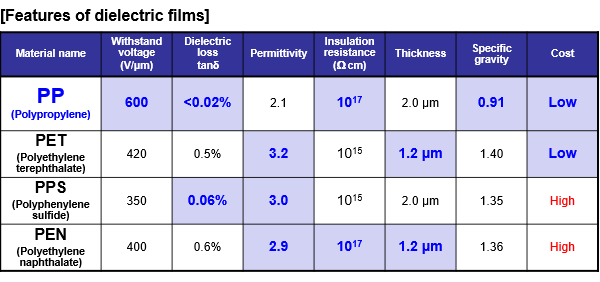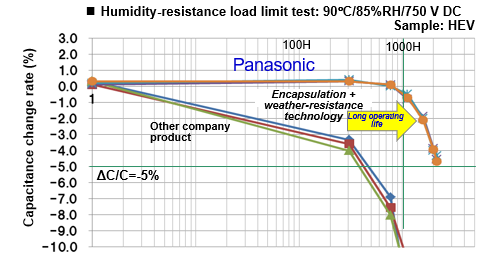Basic Knowledge of Film Capacitors
- Characteristics, Applications -
2022-02-18
The demand for inverters used in environment-related equipment such as EVs/HEVs and solar/wind power generation systems is expanding in the capacitor market. For such applications requiring enduring high voltage exceeding 500 VDC and long-term use for several tens of years along with a high level of safety, demand for film capacitors is increasing.
Excellent features of film capacitors
The indicators for expressing characteristics (performance) of capacitors include the following. "Capacitance" that indicates how much electricity can be stored; "rated voltage" that indicates the strength of pushing out stored electricity; "insulation resistance" that expresses the capability of retaining the stored electricity without leakage; "breakdown strength" that indicates endurance against voltage; "rated current" for expressing the level of current when storing and releasing electricity; and "loss" for expressing loss (resistance) when storing and releasing electricity.
Film capacitors possess more advantages in the characteristics above compared with other types of capacitors.

Small changes in capacitance with a change in temperature
The capacitance of capacitors changes with temperature. For example, in the case of ceramic capacitors, the permittivity of the dielectric body changes with a change in temperature. As a result, the capacitance of capacitors changes. In addition, aluminum electrolytic capacitors also change their capacitance because the electrical conductivity of electrolyte and electrode resistance change with temperature changes.
Ceramic capacitors and aluminum electrolytic capacitors change their capacitance by more than 10% with a change in temperature, but the capacitance of film capacitors changes only several %.
High insulation resistance
Film capacitors use PP (polypropylene), PET (polyethylene terephthalate), PPS (polyphenylene sulfide), PEN (polyethylene naphthalate), etc., as dielectric material, having higher insulation resistance compared with ceramic capacitors and aluminum electrolytic capacitors as well as higher capability of retaining stored electricity. Capacitors generally lose insulation resistance with increased temperatures, but film capacitors maintain insulation resistance better than other types of capacitors.
In addition, film capacitors have a smaller loss of electricity when charging/discharging as compared to other types of capacitors. In particular, film capacitors made with PP dielectric material not only operate with very small loss, but also maintain its small loss even with temperature changes.
No polarity
Some capacitors pose polarity. For example, aluminum electrolytic capacitors are used only with DC operation, but film capacitors have no polarity and can be used with DC or AC.
Fewer failures and longer life
Because the plastic film used for dielectric material of film capacitors is physically stable, film capacitors provide features such as fewer failures and longer life compared with other types of capacitors.
No changes in bias characteristics
Ceramic capacitors change their capacitance when the applied voltage changes, but film capacitors have almost no change in capacitance even when the applied voltage changes. By using these features, use of film capacitors in an audio circuits provides a benefit of decreased distortion and improved sound quality.
Excellent voltage resistance and anti-ripple current operation
While the voltage endurance of aluminum electrolytic capacitors is near 500 V, film capacitor can be used for products with nearly a 4000 V endurance. In the applications requiring high voltage power, such as solar power generation systems with 650 V, HEVs with 48 to 750 V, and railway vehicles with 1000 to 3000 V, inverter power supplies are in operation. For the purpose of voltage stabilization (noise removal, smoothing) of inverter power supplies, film capacitors are essentially required.
Because film capacitors also have excellent anti-ripple current performance (allowable current), they provide an advantage of suppressing self-heating even with a large current flow.
Comparison of characteristics by film material
Superior characteristics of film capacitors have been introduced up to this point. We will now further compare the characteristics of different film materials among film capacitors. When we compare film materials, PP, PET, PPS, and PEN, PP is superior to the other three materials in voltage endurance, dielectric loss, insulation resistance, specific weight, and cost. Only the permittivity is lower than others but overall the performance of PP is superior. General-purpose film capacitors are often made with PP.

Capacitor market and application
As you all know, environment-related markets, including inverters used in EVs/HEVs and solar/wind power generation systems are largely expanding. In particular, demand for high-power applications (high voltage exceeding 500 VDC, large capacity) is increasing. For the performance needed for inverters, film capacitors are often adopted to meet the demand for high voltage endurance, long life, and high reliability.
Up to this point, the superiority of film capacitors has been introduced, but they are not superior in all characteristics.
One of such characteristic is the capacitance per unit volume. When we compare film capacitor and aluminum electrolytic capacitor with the same volume, a large difference of 1/100 exists. For this reason, in an application requiring large capacitance, aluminum electrolytic capacitors, etc., are used for meeting specifically required specifications.
Particularly, in the rapidly expanding environment-related market such as environment-friendly automobiles (for EVs/HEVs) and solar or wind power generation systems, demand for equipment with high voltage and large capacity is increasing. In such a trend toward high voltage applications, film capacitors would be the best choice.
Panasonic film capacitor - Lineup
Here, we introduce the film capacitor lineup offered by Panasonic. In the rough grouping, we have two categories of general-purpose products and custom products. General-purpose products are divided into low voltage and middle/high voltage and others. Low voltage products are divided into surface mount and laminated models. Middle/high voltage products are divided into general-purpose discrete and noise suppression products. Custom products are available in three categories for EVs/HEVs, social infrastructure such as solar power generation systems, and white home appliances.
General-purpose products are developed and produced at the site located in Matsue City, Shimane Prefecture. Custom products are developed and produced at the site located in Tonami City, Toyama Prefecture. In addition to these two sites in Japan, we have production sites in Guangdong province, China for general-purpose and custom products, and in Slovakia in Europe for automotive products.

Panasonic film capacitor - Features
Panasonic’s area of specialty is film capacitors for inverter power sources. Panasonic has over 50% market share of capacitors used for EVs/HEVs, and the technology developed for EV/HEV products is applied to other products, primarily for the products intended for environment-related industries. In comparison with other companies’ film capacitor products, our products feature high-humidity resistance, safety, and long operating life.
High high-humidity resistance
The major cause of deterioration found in film capacitors is the oxidation of electrodes. Panasonic has achieved high moisture resistance reliability through "encapsulation technology" and "weatherproof technology." Encapsulation technology suppresses moisture penetration from the exterior into the element interior by developing exterior case material, filling resin material, and high humidity-resistant metallicon (metal coating for connecting the capacitor's internal electrodes and lead terminals). Weatherproof technology suppresses electrode erosion even when moisture reaches the element, by using highly moisture-resistant evaporated metal and devising processing technology for the internal electrodes.


High safety, long life
Panasonic is developing PP film capable of resisting high voltage and heat by working with chemical film manufacturers. In addition, a safety mechanism is built in the capacitor by applying unique pattern technology. When insulation breakage occurs somewhere in the capacitor, it normally leads to a total breakdown. Panasonic film capacitor, however, is built with many capacitor cells, and when insulation breakage occurs, any such cell is cut out (fuse function) for preventing the expansion of destruction. This 'fuse function' was made possible by Panasonic's in-house vapor deposition process and refining high-accuracy pattern deposition technology.

Summary
Many EV/HEV systems loaded with Panasonic film capacitors for inverter power supply have been used in a variety of climate regions throughout the world. The knowledge obtained from the film capacitors used in inverter power supplies for EVs/HEVs has led to high-reliability capacitors with the added value of high humidity resistance, high safety, and long operating life. The added value of Panasonic film capacitors can meet the requirement of markets and customers in environment-related equipment including solar/wind power generation systems. Panasonic pledges to contribute further to the evolution of environmental equipment, for which market demand will continue to grow in the future.


